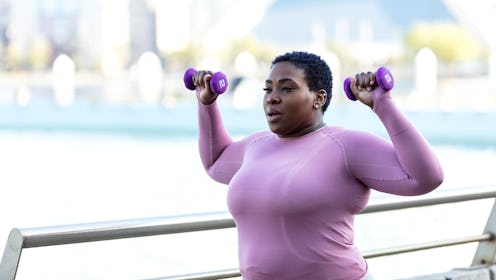Fitness
Functional Vs. Traditional Strength Training, Explained
Hint: It’s what people mean when they say “leg day.”

After you run on the treadmill or complete a cardio workout, you may want to pick up a pair of weights and add in some strength training. But should you go for traditional strength training or functional? Well, it really depends what you’re looking for.
If you’d like to stand in one spot and tone your arms by doing three rounds of bicep curls, traditional is where it’s at. If you’d prefer to move through a series of squats and lunges while holding a kettlebell, functional may be your jam. For many folks, their strength training routine will incorporate both traditional and functional moves. In fact, NASM-certified personal trainer Nolan Parker says the two worlds are colliding now more than ever, with many gym-goers combining both modalities to meet all their fitness goals.
Speaking of, your fitness level will also play a role in whether you lean more toward a traditional or a functional workout. “Most people will begin with traditional strength training because it is easy to follow and learn,” Lesley Wu, a certified personal trainer at WRKOUT, tells Bustle. “Functional strength training requires more knowledge and experience to execute specific exercises properly,” he says, pointing to moves like the “farmer’s walk.”
To break it down further and help you decide, here are the features of each strength training technique, as well as the benefits.
Traditional Strength Training
If you’re looking to tone a specific muscle group, like your legs, glutes, or abs, then traditional strength training might be a good fit. As NASM-certified personal trainer Natasha Funderburk says, “Traditional strength training is when you work on building strength or muscle bulk through standard weight lifting or resistance training methods.” It includes using weight machines, free weights, and even exercise bands to isolate one muscle at a time.
When you hear someone say they’re heading to the gym for “leg day,” they’re likely about to do some traditional strength training. With this method, “a gym-goer typically breaks up their training week into three to five workouts where a specific area of the body is the emphasis of each workout,” Parker adds. “This style of training often focuses on muscle hypertrophy where the user performs three to five sets of eight to 12 reps.” The goal is to choose a weight that’s just heavy enough to be challenging so that your muscles are tired (read: stronger) by the end of your reps.
Traditional Strength Training Benefits
According to Funderburk, traditional strength training is ideal for anyone who wants to build up a specific muscle. “Traditional strength training is also good for athletes and those who are working towards a goal,” she says. For example, runners can benefit from incorporating glute training into their routine.
Traditional strength training has also been shown to improve bone density by putting stress on your bones (in a good way) while also increasing mobility in your joints. Funderburk says it all adds up to reduce your risk of injury, too, because you’re literally training your body to hold itself in a stronger, more supportive way.
Functional Strength Training
Functional strength training, on the other hand, focuses on exercises that will be useful to the way your body moves in everyday life. From walking up stairs to carrying groceries, it’ll all feel easier once you start a functional strength training routine.
Let’s use the groceries as an example. “Training through functional movements with exercises like the farmer’s walk or suitcase carry can [come in handy] when you want to make the single trip inside with your groceries,” Wu says. “As the name suggests, functional strength training focuses on executing everyday functions with more ease.”
These moves are also more dynamic, Funderburk says, which is why functional strength training might appeal to someone who’s been exercising for a while. Instead of having a “leg day,” a functional routine will work multiple areas of the body, where traditional strength training focuses on one isolated movement at a time.
Benefits Of Functional Strength Training
Both strength training modalities improve joint mobility, increase your range of motion, and improve bone density. But functional training may better translate to everyday life. Wu says moves like lunges, squats, farmer’s walks, and other functional strength training moves give your body a strong core so that everything feels easier.
As Funderburk says, “There is definitely benefit to both styles for all types of people: athletes, and non-athletes alike can benefit from both getting stronger and working on more dynamic moves to help with everyday life.”
Studies referenced:
de Resende-Neto AG, do Nascimento MA, de Sá CA, Ribeiro AS, Desantana JM, da Silva-Grigoletto ME. Comparison between functional and traditional training exercises on joint mobility, determinants of walking and muscle strength in older women. Journal of Sports Medicine and Physical Fitness. 2019 Oct;59(10):1659-1668. doi: 10.23736/S0022-4707.19.09751-2. Epub 2019 Jun 19. PMID: 31219252.
Gray M, Di Brezzo R, Fort IL. The effects of power and strength training on bone mineral density in premenopausal women. Journal of Sports Medicine and Physical Fitness. 2013 Aug;53(4):428-36. PMID: 23828291.
Sources:
Nolan Parker, NASM-certified personal trainer
Lesley Wu, certified personal trainer
Natasha Funderburk, NASM-certified personal trainer
This article was originally published on